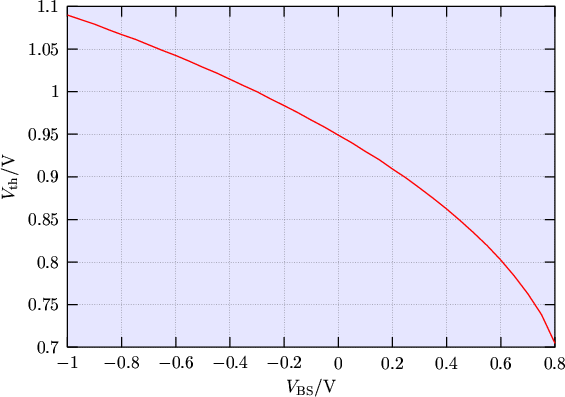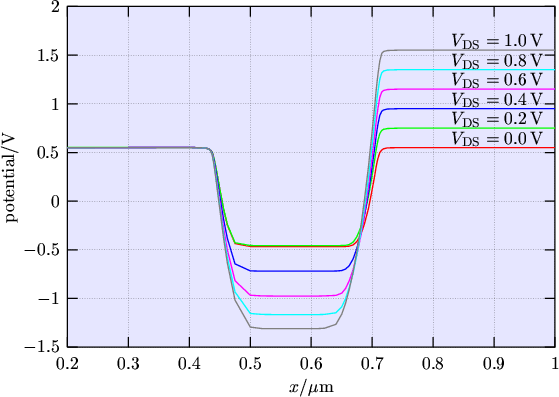A characteristic difference between a drift-diffusion and an energy transport simulation is that while the carriers
stay at lattice temperature in the former one, they can reach significantly higher
temperatures in the latter one. Carrier heating occurs in the pinch-off region near the
drain. While the vast majority of electrons from the channel flow into the drain, some of
them have enough energy to diffuse into the p-doped body, where a certain percentage
recombines with holes. The remaining electrons flow into the source and drain regions, and
are of no harm. The problem is, that pair recombination causes a lack of holes and hence a
steady decrease of the body potential. The difference between drift-diffusion and energy transport can be seen in
Fig. 4.4 and Fig. 4.9, respectively, where the distributed
potential is shown at a vertical position of
 .
.
In Fig. 4.9 an anomalous drop of the body potential is observed with
increasing drain voltage. Not only is the drain-body junction reverse biased but also the
source-body junction. Therefore, leakage currents from both junctions flow into the floating
body. Clearly, the dropping body potential has an influence to the drain current via the body
effect (Fig. 4.10). The gate overdrive
 gets
reduced because
gets
reduced because
 increases while
increases while
 stays the same yielding to a
reduced channel charge and therefore to a smaller drain current.
stays the same yielding to a
reduced channel charge and therefore to a smaller drain current.
Figure 4.10:
Threshold voltage as a function of the body bias of the SOI with a body
contact (Device 2) obtained by drift-diffusion simulations. The threshold voltage was
defined as the gate-source voltage at which the drain current equals
 .
.
|
 |
The balance of the drift and diffusion currents is affected by carrier heating as follows.
 |
(4.1) |
This means that carrier diffusion in the energy transport model is enhanced by a factor
 as
compared with the drift-diffusion model.
as
compared with the drift-diffusion model.
To the occurrence of the current drop four partial effects contribute:
- In device regions where electrons reach high temperatures, such as the pinch-off
region, electrons diffuse farther away from the interface and spread deeper into the
p-body. This effect is also known as real space transfer (RST).
- Excess electrons accruing from the pinch-off region recombine with holes in the p-body
(Fig. 4.1).
- Removing holes causes the body potential to drop and the source-body junction to
become reverse biased. A steady state is reached when the reverse junction leakages of
both the source-body and drain-body junctions compensate for the recombining holes.
- Due to the body effect the drain current decreases with decreasing body potential.
The RST of hot electrons from the pinch-off region to the depletion region
underneath is at the outset of the effect. With drift-diffusion, the RST does not appear
since electrons cannot move from the low quasi FERMI level (QFL) in the
pinch-off region to any higher QFL in the depletion region or in the p-body. The
difference in the electron concentration between drift-diffusion and energy transport can be seen clearly in
Fig. 4.11 and Fig. 4.12. In Fig. 4.12 the spread of electrons into
the body is remarkable. This difference has a great impact on the
SHOCKLEY-READ-HALL generation/recombination rates depicted in
Fig. 4.13 to Fig. 4.16. The critical area is the
depletion region underneath the pinch-off region. While the drift-diffusion simulation predicts carrier
generation in this area, which is the expected situation in this depletion region, in the
energy transport simulation carrier recombination takes place because of the excess electrons. As a
consequence of recombination, holes are removed from the p-body. If the body is contacted,
the recombining holes are substituted by holes from the body contact, leading to a small
substrate current which flows into the body (Fig. 4.7). However, in an
SOI MOSFET the situation is different. The holes removed by recombination make the
body potential drop. Eventually the reverse bias of the source-body and drain-body junctions
becomes large enough such that the junction leakage currents compensate for the recombination
current and a steady state is reached. Via the body effect the drop of the body potential
causes the drain current to decrease.
Figure 4.11:
Electron concentration in the SOI (Device 1) obtained by a drift-diffusion
simulation.
|
![\includegraphics[width=.55\textwidth]{eps/3D_n_DD.epsi}](img920.png) |
Figure 4.12:
Electron concentration in the SOI (Device 1) obtained by an energy transport
simulation.
|
![\includegraphics[width=.55\textwidth]{eps/HD_otherLimits.epsi}](img921.png) |
Figure 4.13:
SRH net-generation in the SOI (Device 1) obtained by a drift-diffusion
simulation. Generation occurs only in the drain-body junction.
|
![\includegraphics[width=.55\textwidth]{eps/3D_Generation_DD.epsi}](img922.png) |
Figure 4.14:
SRH net-generation in the SOI (Device 1) obtained by an energy transport
simulation. Generation occurs in both junctions.
|
![\includegraphics[width=.55\textwidth]{eps/3D_Generation_ET.epsi}](img923.png) |
Figure 4.15:
SRH net-recombination in the SOI (Device 1) obtained by a drift-diffusion
simulation. Recombination occurs only in the source-body junction.
|
![\includegraphics[width=.55\textwidth]{eps/3D_Recombination_DD.epsi}](img924.png) |
Figure 4.16:
SRH net-recombination in the SOI (Device 1) obtained by an
energy transport simulation. Recombination occurs in the whole p-body.
|
![\includegraphics[width=.55\textwidth]{eps/3D_Recombination_ET.epsi}](img925.png) |
M. Gritsch: Numerical Modeling of Silicon-on-Insulator MOSFETs PDF

![]() gets
reduced because
gets
reduced because
![]() increases while
increases while
![]() stays the same yielding to a
reduced channel charge and therefore to a smaller drain current.
stays the same yielding to a
reduced channel charge and therefore to a smaller drain current.


![\includegraphics[width=.55\textwidth]{eps/HD_otherLimits.epsi}](img921.png)
![\includegraphics[width=.55\textwidth]{eps/3D_Generation_DD.epsi}](img922.png)
![\includegraphics[width=.55\textwidth]{eps/3D_Generation_ET.epsi}](img923.png)
![\includegraphics[width=.55\textwidth]{eps/3D_Recombination_DD.epsi}](img924.png)
![\includegraphics[width=.55\textwidth]{eps/3D_Recombination_ET.epsi}](img925.png)